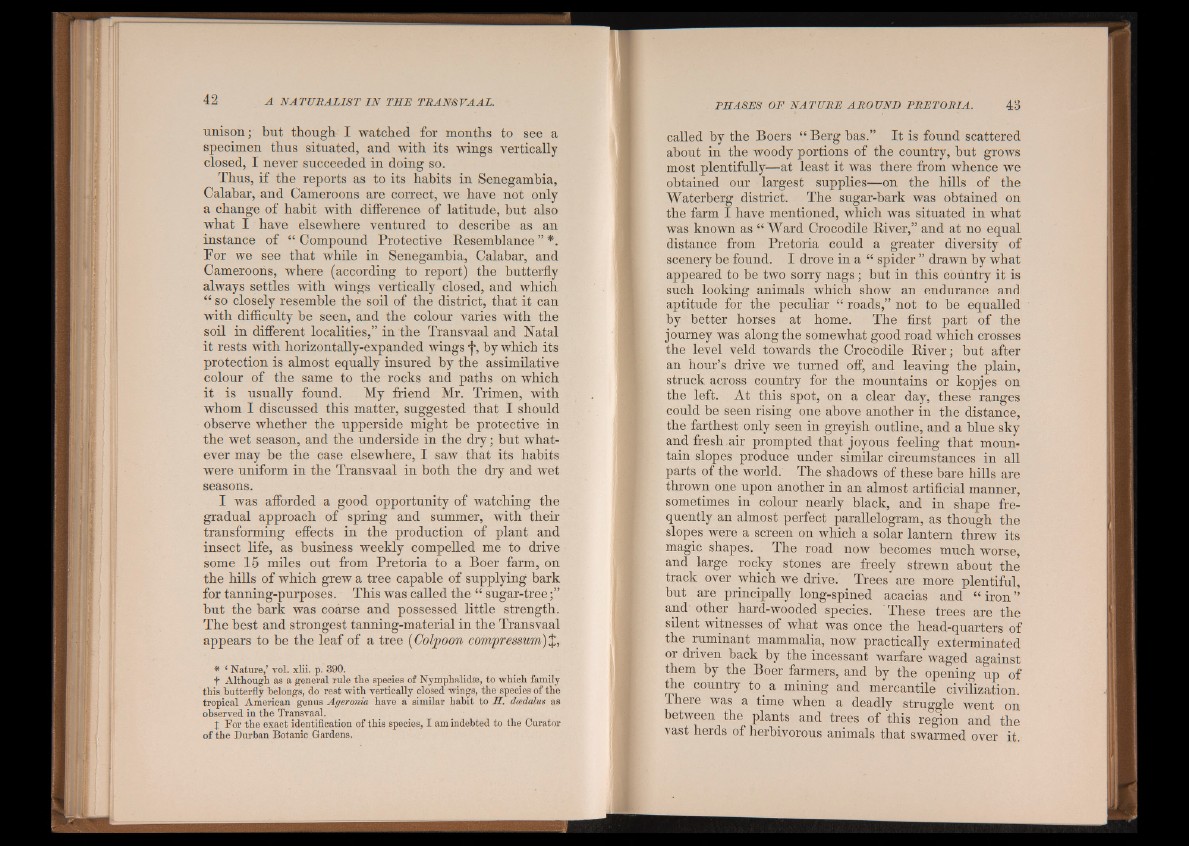
unison; bnt though I watched for months to see a
specimen thus situated, and with its wings vertically
closed, I never succeeded in doing so.
Thus, if the reports as to its habits in Senegambia,
Calabar, and Cameroons are correct, we have not only
a change of habit with difference of latitude, but also
what I have elsewhere ventured to describe as an
instance of “ Compound Protective Resemblance ” *.
For we see that while in Senegambia, Calabar, and
Cameroons, where (according to report) the butterfly
always settles with wings vertically closed, and which
“ so closely resemble the soil of the district, that it can
with difficulty be seen, and the colour varies with the
soil in different localities,” in the Transvaal and Natal
it rests with horizontally-expanded wings f, by which its
protection is almost equally insured by the assimilative
colour of the same to the rocks and paths on which
it is usually found. My friend Mr. Trimen, with
whom I discussed this matter, suggested that I should
observe whether the upperside might be protective in
the wet season, and the underside in the dry; but whatever
may be the case elsewhere, I saw that its habits
were uniform in the Transvaal in both the dry and wet
seasons.
I was afforded a good opportunity of watching the
gradual approach of spring and summer, with their
transforming effects in the production of plant and
insect life, as business weekly compelled me to drive
some 15 miles out from Pretoria to a Boer farm, on
the hills of which grew a tree capable of supplying bark
for tanning-purposes. This was called the “ sugar-tree
but the bark was coarse and possessed little strength.
The best and strongest tanning-material in the Transvaal
appears to be the leaf of a tree (Colpoon compressum)$,
* ‘ Nature,’ vol. xlii. p. 390.
f Although as a general rule the species of Nymphalidse, to which family
this butterfly belongs, do rest with -vertically closed wings, the species of the
tropical American genus Ageronia have a similar habit to H. dcadalus as
observed in the Transvaal.
J For the exact identification of this species, I am indebted to the Curator
of the Durban Botanic Gardens.
called by the Boers “ Berg bas.” It is found scattered
about in the woody portions of the country, but grows
most plentifully—at least it was there from whence we
obtained our largest supplies—on the hills of the
Waterberg district. The sugar-bark was obtained on
the farm I have mentioned, which was situated in what
was known as “Ward Crocodile River,” and at no equal
distance from Pretoria could a greater diversity of
scenery be found. I drove in a “ spider ” drawn by what
appeared to be two sorry nags ; but in this country it is
such looking animals which show an endurance and
aptitude for the peculiar “ roads,” not to be equalled
by better horses at home. The first part of the
journey was along the somewhat good road which crosses
the level veld towards the Crocodile River; but after
an hour’s drive we turned off, and leaving the plain,
struck across country for the mountains or kopjes on
the left. At this spot, on a clear day, these ranges
could be seen rising one above another in the distance,
the farthest only seen in greyish outline, and a blue sky
and fresh,air prompted that joyous feeling that mountain
slopes produce under similar circumstances in all
parts of the world. The shadows of these bare hills are
thrown one upon another in an almost artificial manner,
sometimes in colour nearly black, and in shape frequently
an almost perfect parallelogram, as though the
slopes were a screen on which a solar lantern threw its
magic shapes. The road now becomes much worse,
and large rocky stones are freely strewn about the
track over which we drive. Trees are more plentiful,
but are principally long-spined acacias and | iron 1
and' other hard-wooded species. These trees are the
silent witnesses of what was once the head-quarters of
the ruminant mammalia, now practically exterminated
or driven back by the incessant warfare waged against
them by the Boer farmers, and by the opening up of
the country to^ a mining and mercantile civilization.
There was a time when a deadly struggle went on
between the plants and trees of this region and the
vast herds of herbivorous animals that swarmed over it.